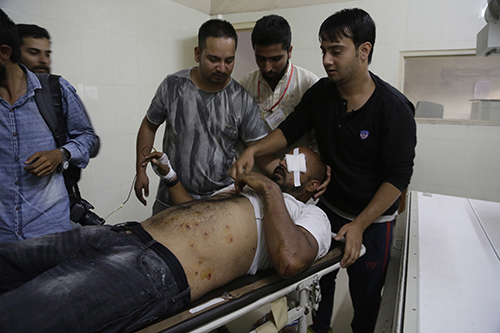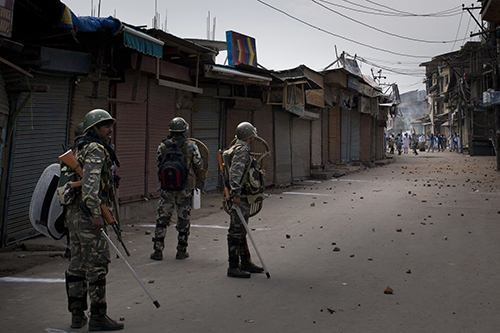For four months, the Indian state of Jammu and Kashmir has been under a curfew imposed after protests broke out when Burhan Wani, a commander of Hizbul Mujahideen, a pro-independence militant organization that advocates for Kashmir’s independence from India, was killed in clashes with the Indian army. Journalists have been caught in the crossfire as protesters clash with police and authorities try to regain control by imposing curfews and blocking access to the internet.
CPJ has documented cases of protesters attacking the press and authorities ordering newspapers to stop publication. Journalists have also reported being injured by police firing pellet guns to counter protests. Muzamil Mattoo and Zuhaib Maqbool, two freelance photojournalists, are among those to have been injured by pellets. On September 4, the journalists were covering a gathering of about 40 people during the curfew in the Rainawari area of Srinagar. Mattoo said that when police arrived to break up the gathering, an officer fired at him and Maqbool, despite the photographers identifying themselves to him as press.
In an interview with CPJ, Mattoo recounts the attack and explains why the protests of 2016 are different from those in 2008 and 2010.
[EDITOR’S NOTE: Amit Kumar, senior superintendent of the Jammu and Kashmir police in Srinagar, did not respond to CPJ’s telephone calls and text messages requesting comment.]
This interview has been edited for clarity.
Can you describe the attack on you?
[We were covering] a gathering of 40 to 50 people. We were clicking pictures and, all of a sudden, we heard a cry of “the police is coming.” As the alley was too small, Zuhaib, me and another photographer couldn’t manage to exit. Soon, the police arrested the youths and left, so we ran after them to keep ourselves safe. When we’re on the side of the police, the worst that can happen is that we’ll be hit by a stone thrown by a protester. If we’re on the other side, we might be hit by a shell, bullets, pellets…anything. So Zuhaib and me went to the police [side] and started clicking pictures. [The police] told us, “Don’t click the pictures” in a tone that was too rude. When [the police] reached the other alley, they found it was blocked already from the front and they were stuck. That’s where the people came from and started chasing them with stones.
Zuhaib and I decided to leave since it wasn’t safe. Zuhaib had already crossed the road and I was in the middle when suddenly a policeman came out with a pellet gun in his hand. He was barely 20ft to 30ft away. Zuhaib and I waved our cameras and said “press!” and we thought he saw us. He went inside [an empty alley] and, within seconds, came out ready to shoot us – his gun was pointing towards us. I got an intuition that he’d shoot and I ducked. Most pellets hit my head, some on my back and some on my left arm. I saved my face but Zuhaib was hit all over his body and his eye got damaged. He has lost the sight in his left eye and doctors say it will take another six months before they can say for sure whether he will recover his sight.

How many pellets hit you and what were the consequences of this injury?
Fifteen to 30 pellets hit my head and around five each on my left arm and back. I managed to take [some] out myself. But I had to go to the Shri Maharaja Hari Singh Hospital the same day to get the ones in my head removed. The pellets that were visible immediately were pulled out. This is one of only two hospitals in Srinagar where critical care facilities are available, and since there was a rush of injured people I was asked to go back. After about 15 days, my head and skull got swollen. I wasn’t able to sleep on my left side and had a cold sensation in my mouth. I got myself checked up and there were still some pellets stuck in my skull. A week later, I consulted a neurosurgeon. It took him more than three hours to remove the pellets stuck inside my skull.
Did you lodge a formal complaint about the attack on you and Zuhaib?
We tried to. We have to go through the Kashmir Press Photographers’ Association. At first, [the photographer’s association] thought that we were shooting photos from the protesters’ side without taking appropriate measures, i.e. to shoot from the side of the police to minimize injuries. Three days later [after they reviewed our case,] they called us again, only to tell us that it’s too late to file a complaint.
Who fired at you?
It was the Jammu and Kashmir police because I saw four of their vehicles and they were the only ones chasing protesters. What we have seen from the current uprising is that most of the police officers don’t wear a [name] badge, so we don’t know who they are. They don’t wear their stars or their badges and they cover their faces. This guy [who shot at us] also had his face covered and he was without his badge and everything. But from the color of his uniform, we knew that he was from the Jammu and Kashmir police.
Jammu and Kashmir has seen similar protests in 2008 and 2010. During those times there was a clampdown on the media and a cameraman died when security forces opened fire on protesters. Are journalists at greater risk now?
In 2010, I didn’t see anything like this happen. But this time, in the first month of the uprising itself, I heard that a 17-year-old boy was taken away by the police for posting a tweet. [CPJ was unable to verify this claim.] After that, they stopped the press from reporting for three days. Newspapers were banned, many Facebook pages were blocked, and internet (mobile and broadband) was banned for many days. There have been other instances too. I have a curfew pass issued by the divisional commissioner, but the police wouldn’t let me go through areas under curfew. Once, a policeman just threw the pass on my face and said, “Tear it apart! I don’t care! Just go back or I’ll beat you up!” So it’s worse this time.
[Reporting from New Delhi]
